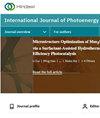利用平板太阳能热水器满足美国某公寓供暖需求的能源-环境一年期动态模拟与排名分析:综述
IF 2.1
4区 工程技术
Q3 CHEMISTRY, PHYSICAL
引用次数: 2
摘要
如今,由于对水加热的需求不断增加,太阳能热水器(SWHs)是一种合适的替代基于化石燃料或电力燃料的加热。太阳能采暖因其减少环境污染和确保未来能源安全而受到广泛关注。此外,从长远来看,它具有成本效益。鉴于上述重要性,缺乏对美国不同州住宅规模供热潜力的全面审查。此外,如何找到最合适的地方使用污水处理厂至今尚未研究。因此,在本工作中,首次使用TSOL商业软件对美国50个州中心进行了为期一年的能源环境评价。采用逐步加权评价比率分析(SWARA)和加权总和积评价(WASPAS)计算方法,分别对研究站点的标准进行加权和排序。结果表明,在研究的8个参数中,“总太阳能分数”和“太阳能对生活热水的贡献”参数的最终归一化权重分别最高和最低。使用决策矩阵的WASPAS方法表明,Phoenix、Santa Fe和Tallahassee站分别是使用SWHs最好的3个站,而Juneau、Olympia和Montpelier站分别是使用SWHs最不合适的3个站。VIekriterijumsko KOmpromisno Rangiranje (VIKOR)、智能交通系统部署分析系统(IDAS)和TOPSIS (TOPSIS)方法也验证了本工作的结果,两者完全一致。经济分析结果显示,每千瓦发电价格为0.021美元的圣达菲电站是太阳能发电最便宜的电站。本文章由计算机程序翻译,如有差异,请以英文原文为准。
Energy-Environmental One-Year Dynamic Simulation and Ranking Analysis of Using Flat Plate Solar Water Heater to Supply the Heating Demand of an Apartment in the USA: A Comprehensive Review
Nowadays, owing to the increasing demand for water heating, solar water heaters (SWHs) are an appropriate alternative to heating based on fossil or electric fuels. Solar heating has received a lot of attention due to its reduction of environmental pollution and ensuring future energy security. Moreover, it is cost-effective in the long run. Given the importance of the above, there is a lack of a comprehensive review of the potential for heat supply at the residential scale in different US states. In addition, finding the most suitable place to use SWHs has not been studied so far. Therefore, in the present work, for the first time, the energy-environmental assessment of 50 US state centers during a one-year period has been done using TSOL commercial software. Furthermore, using step-wise weight assessment ratio analysis (SWARA) and weighted aggregated sum product assessment (WASPAS) computational methods, the weighting of criteria and ranking of studied stations were performed, respectively. The results indicated that of the eight parameters studied, the parameters “total solar fraction” and “solar contribution to domestic hot water” have the highest and lowest final normalized weight, respectively. Moreover, the WASPAS method using the decision matrix showed that Phoenix, Santa Fe, and Tallahassee stations are the top 3 stations in terms of using SWHs, respectively, and Juneau, Olympia, and Montpelier stations are three inappropriate stations in this regard, respectively. The VIekriterijumsko KOmpromisno Rangiranje (VIKOR), intelligent transportation system deployment analysis system (IDAS), and technique for order of preference by similarity to ideal solution (TOPSIS) methods also validated the results of the present work, which were completely consistent. The results of the economic analysis revealed that the Santa Fe station with the price of each kW of energy produced at $0.021 has the cheapest solar heat generation.
求助全文
通过发布文献求助,成功后即可免费获取论文全文。
去求助
来源期刊
CiteScore
6.00
自引率
3.10%
发文量
128
审稿时长
3.6 months
期刊介绍:
International Journal of Photoenergy is a peer-reviewed, open access journal that publishes original research articles as well as review articles in all areas of photoenergy. The journal consolidates research activities in photochemistry and solar energy utilization into a single and unique forum for discussing and sharing knowledge.
The journal covers the following topics and applications:
- Photocatalysis
- Photostability and Toxicity of Drugs and UV-Photoprotection
- Solar Energy
- Artificial Light Harvesting Systems
- Photomedicine
- Photo Nanosystems
- Nano Tools for Solar Energy and Photochemistry
- Solar Chemistry
- Photochromism
- Organic Light-Emitting Diodes
- PV Systems
- Nano Structured Solar Cells

 求助内容:
求助内容: 应助结果提醒方式:
应助结果提醒方式:


